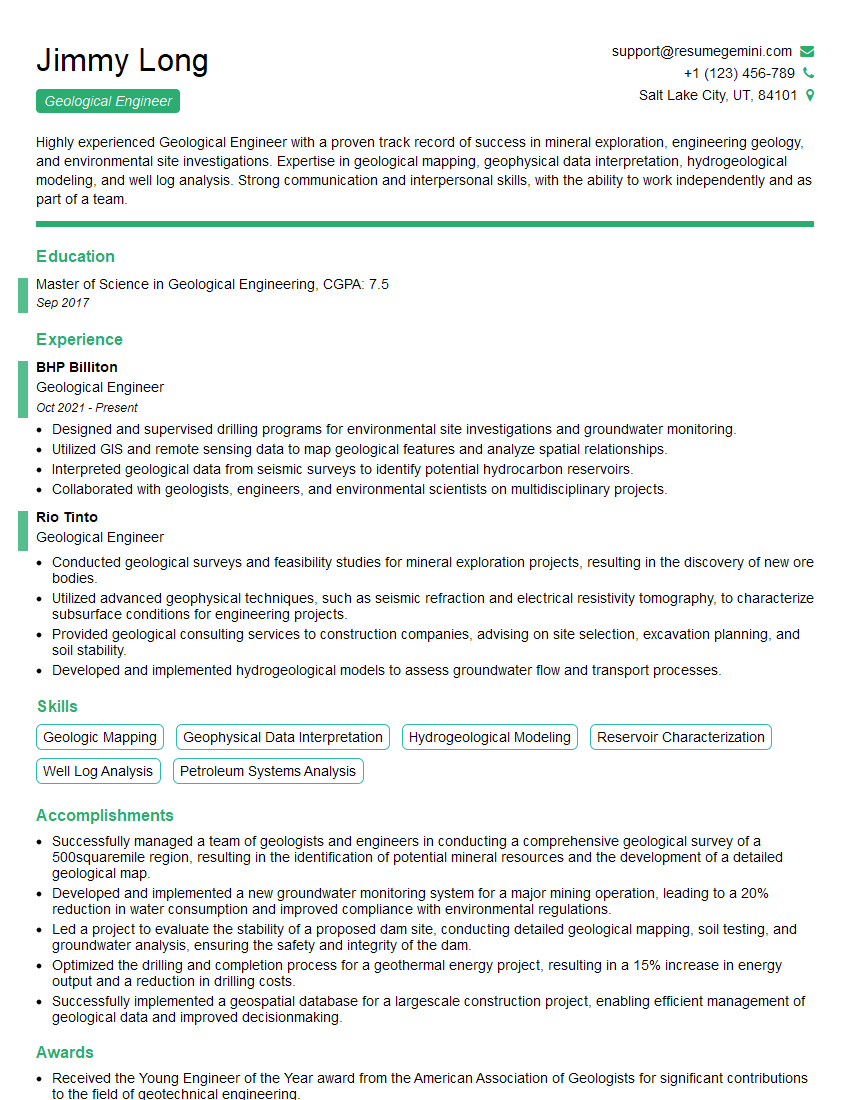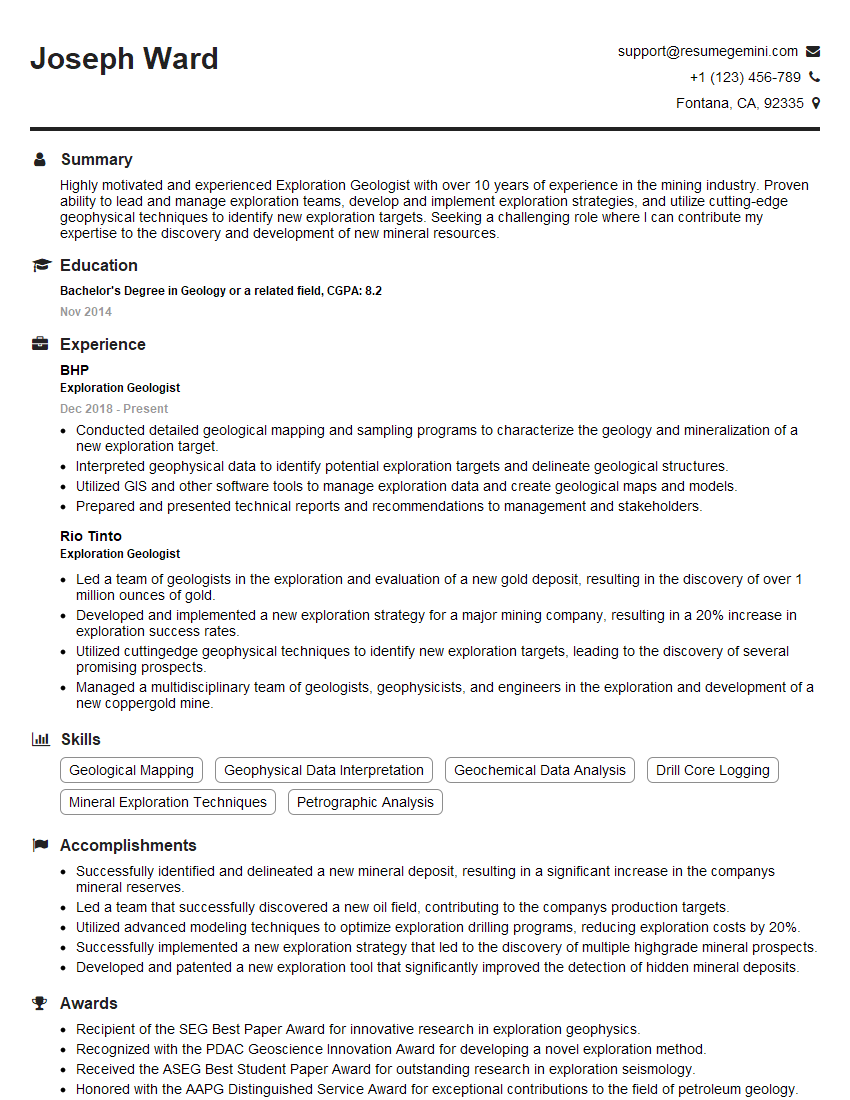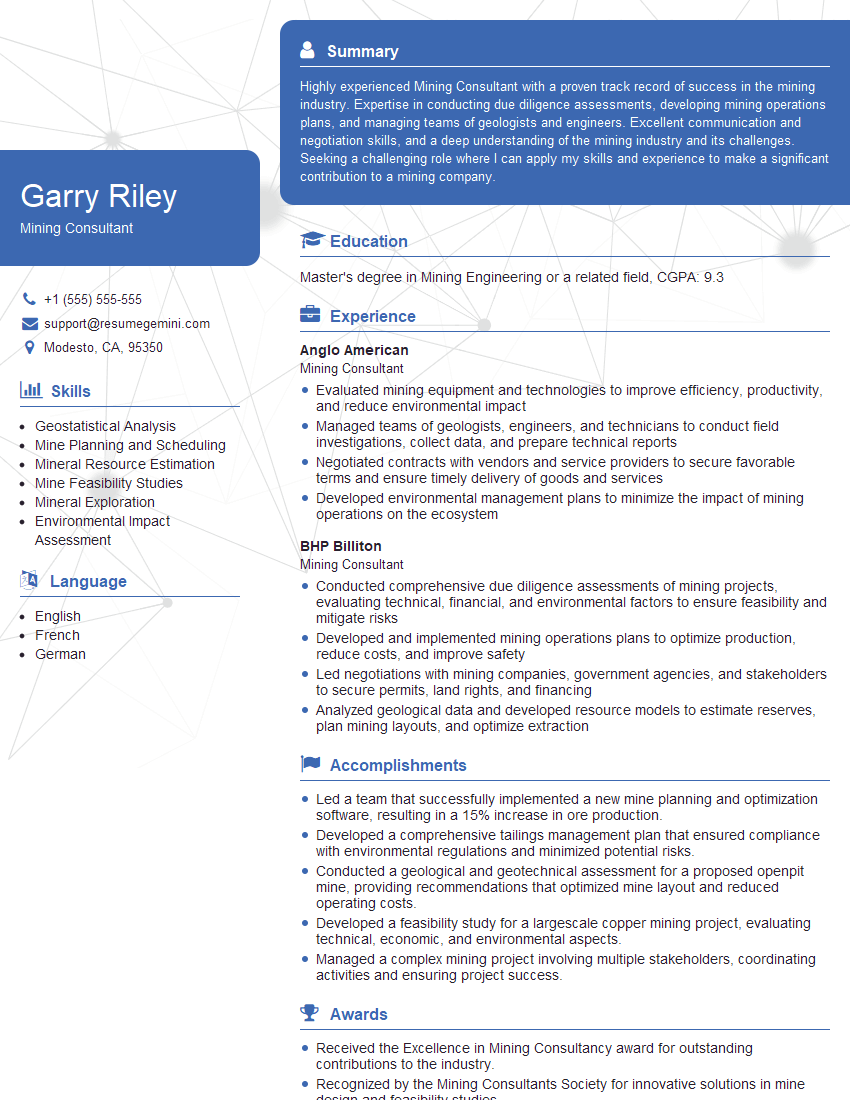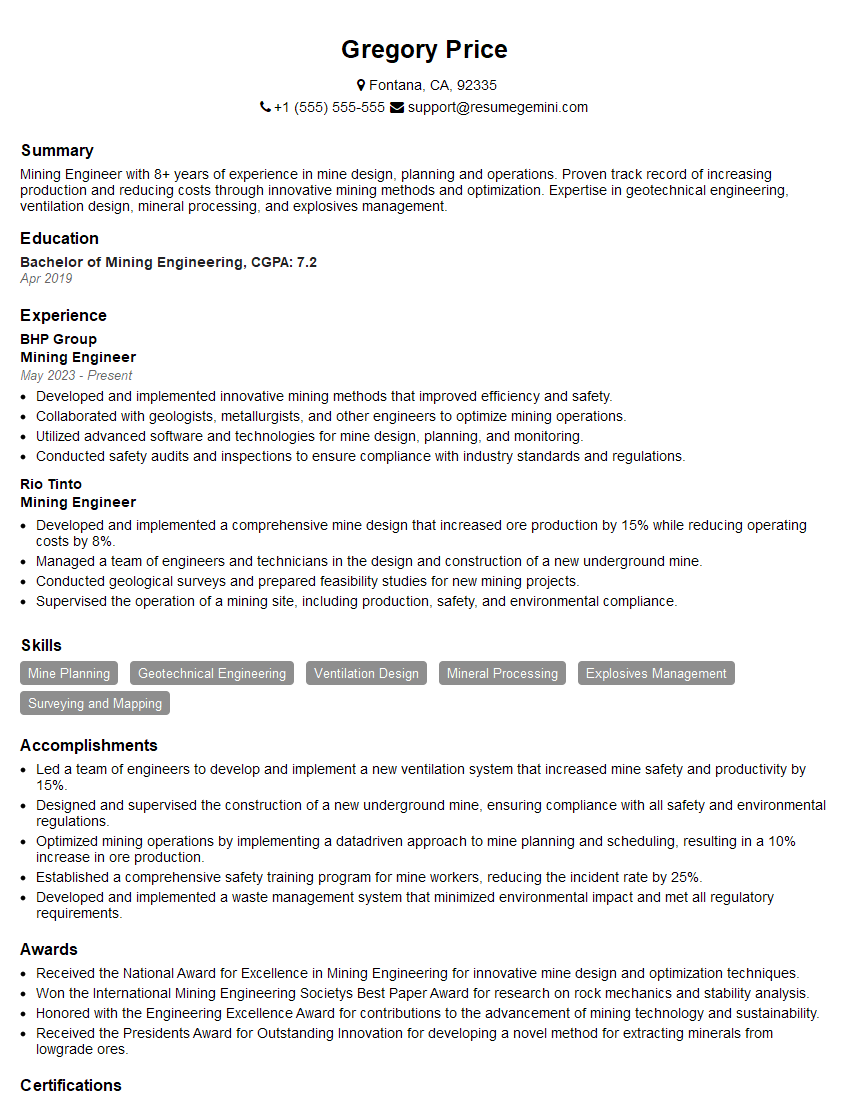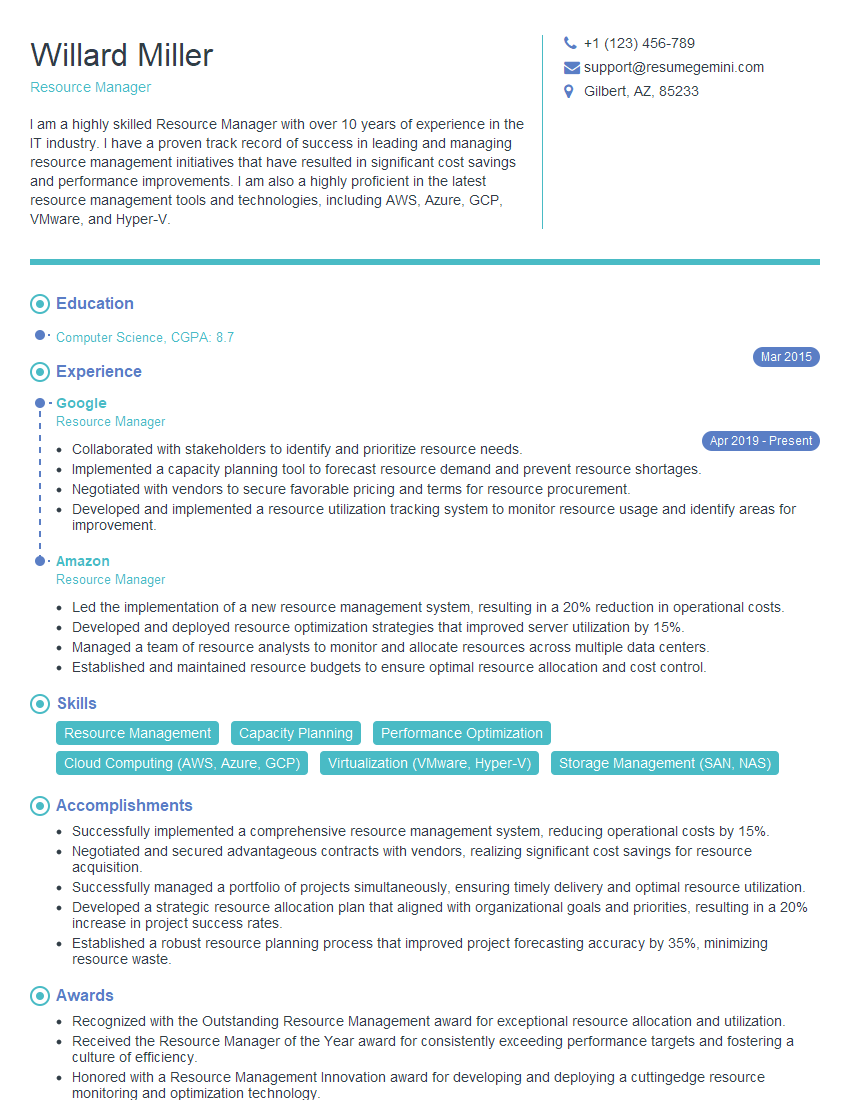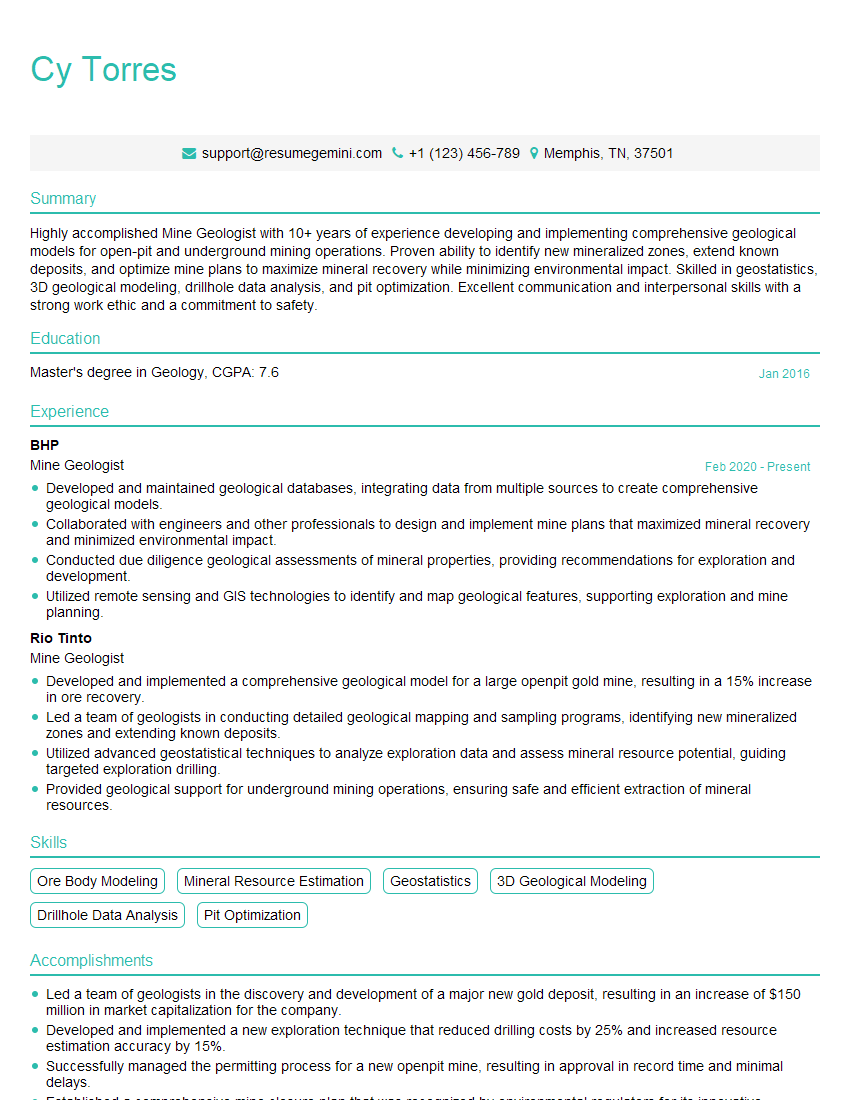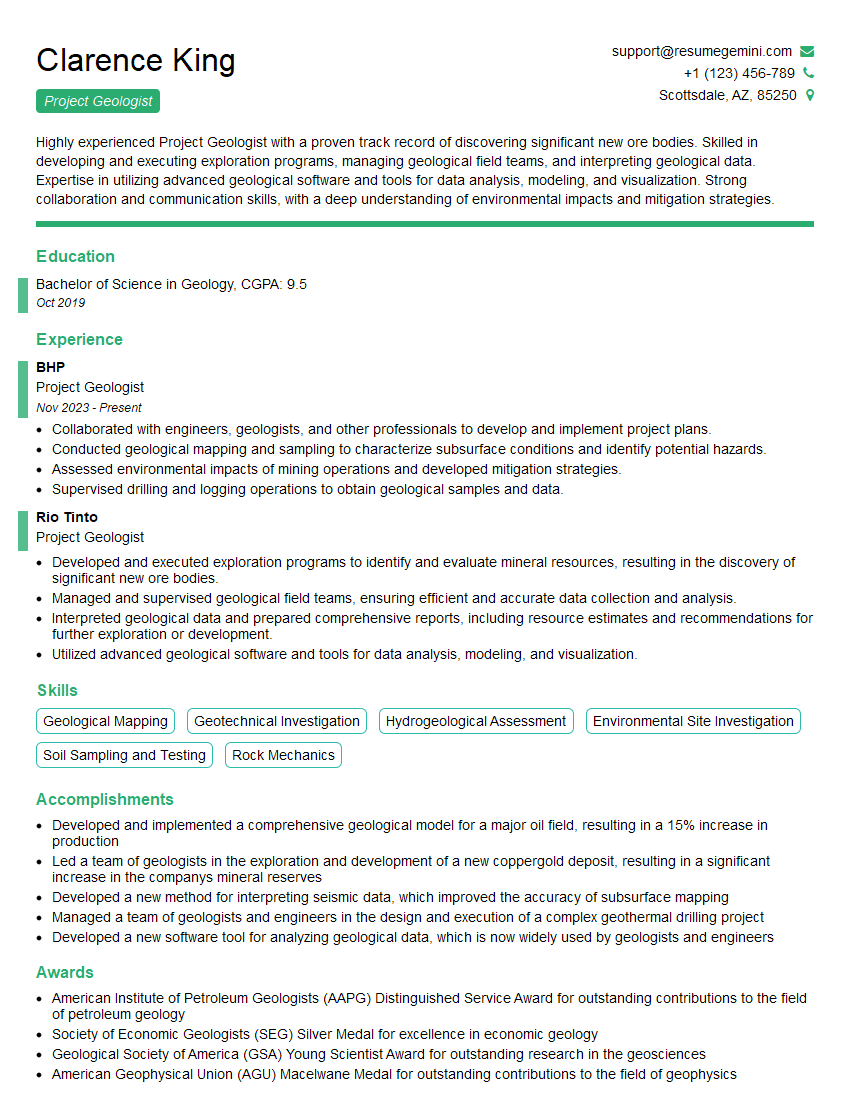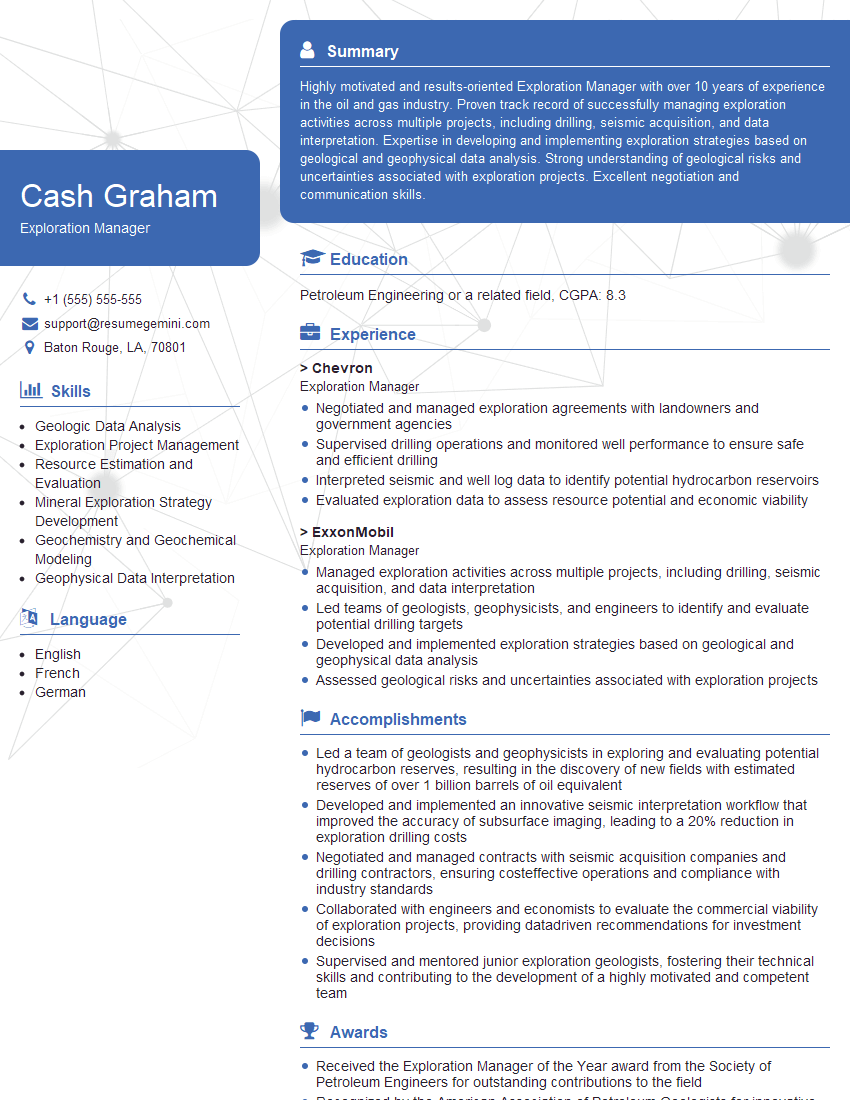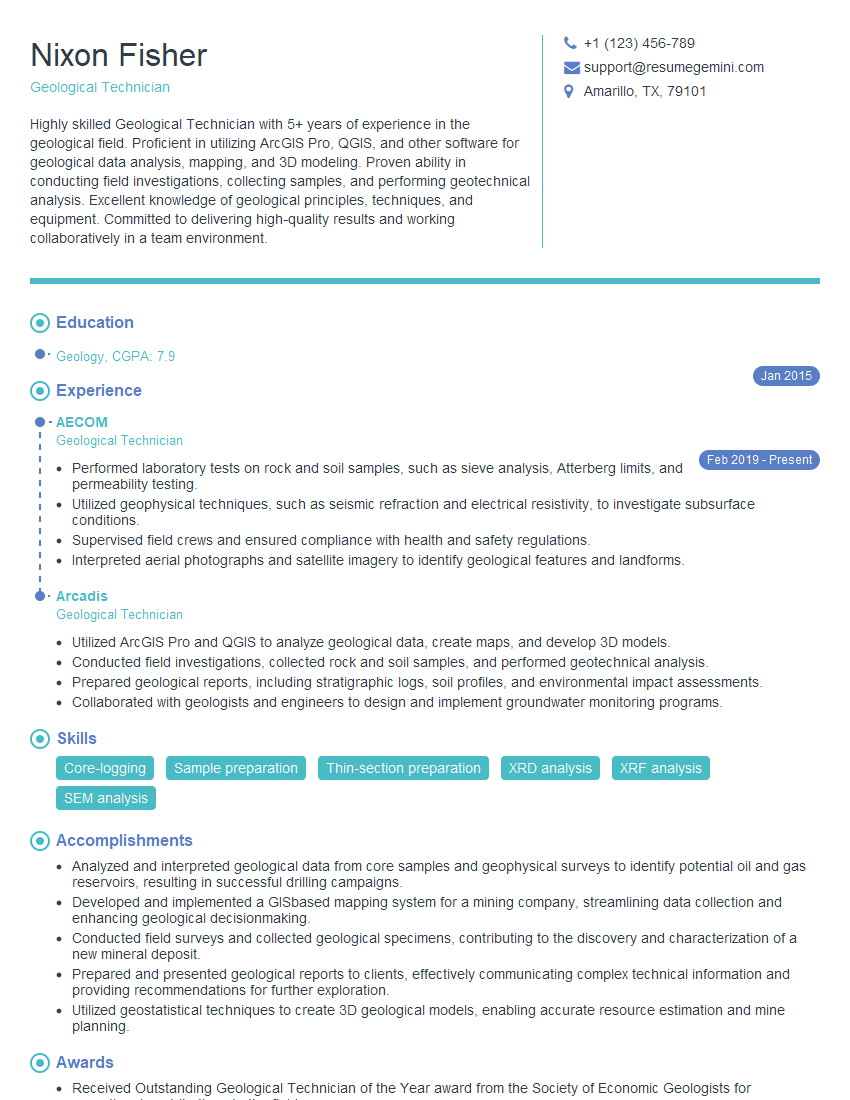Are you ready to stand out in your next interview? Understanding and preparing for Knowledge of Orebody Delineation and Reserve Estimation interview questions is a game-changer. In this blog, we’ve compiled key questions and expert advice to help you showcase your skills with confidence and precision. Let’s get started on your journey to acing the interview.
Questions Asked in Knowledge of Orebody Delineation and Reserve Estimation Interview
Q 1. Explain the difference between exploration, delineation, and reserve estimation.
Orebody delineation and reserve estimation are crucial steps in mining, but they represent distinct phases. Think of it like building a house: exploration is finding the land, delineation is surveying the plot and designing the house’s footprint, and reserve estimation is calculating the materials needed and their cost.
- Exploration: This is the initial stage focused on discovering mineral deposits. It involves geological surveys, geophysical methods (like airborne surveys), geochemical analysis (soil and rock samples), and drilling to identify areas with potential mineralization. The goal is to find promising targets.
- Delineation: Once a promising orebody is discovered, delineation begins. This involves more detailed drilling programs (infill drilling) to define the orebody’s geometry, grade (concentration of valuable minerals), and boundaries. This stage utilizes geostatistical methods to create a 3D model of the orebody.
- Reserve Estimation: This is the final stage before mine planning. It uses the delineated orebody model to estimate the quantity and quality of the economically recoverable ore. It takes into account factors like mining methods, metallurgical recoveries, and economic parameters (commodity prices, operating costs) to calculate the reserves.
In short: Exploration finds it, delineation defines it, and reserve estimation quantifies its economic value.
Q 2. Describe the various methods used for orebody modeling.
Several methods are used for orebody modeling, each with its strengths and weaknesses. The choice depends on the orebody’s complexity, data availability, and project requirements.
- Wireframe Modeling: This is a simpler method where geologists manually trace the orebody boundaries on cross-sections. It’s suitable for simpler orebodies but can be subjective and less accurate for complex geometries.
- Interpolation Methods: These methods estimate values (e.g., grade) at unsampled locations based on nearby sampled values. Common methods include Inverse Distance Weighting (IDW) and Kriging (a geostatistical method).
- Implicit Modeling: This uses a mathematical function to represent the orebody, often based on geological understanding and data. Examples include polynomial interpolation and indicator kriging.
- 3D Geological Modeling Software: Specialized software packages (e.g., Leapfrog Geo, MineSight) are used to integrate various data types (drillhole data, geological maps, geophysical data) and create sophisticated 3D models. These packages often incorporate multiple modeling techniques.
For example, a porphyry copper deposit might be modeled using implicit modeling to capture its smooth, continuous nature, while a vein-type gold deposit might benefit from a combination of wireframing and kriging.
Q 3. What are the key assumptions made during reserve estimation?
Reserve estimation relies on several key assumptions that significantly impact the final results. It’s crucial to be aware of these assumptions and their potential impact on the project’s economics.
- Geological Continuity: The model assumes that the geological characteristics observed in sampled areas are representative of the unsampled areas. This is a critical assumption and often validated through geostatistical analysis.
- Metallurgical Recoveries: It assumes a specific percentage of the metal in the ore will be recovered during processing. These recoveries are estimated through metallurgical testing and can vary depending on ore grade and mineralogy.
- Mining Methods: The chosen mining method (open pit, underground) affects the amount of ore that can be economically extracted. The model needs to account for mining losses, dilution, and recovery factors.
- Economic Parameters: The estimation uses assumptions about commodity prices, operating costs, and discount rates. Changes in these parameters can significantly alter the economic viability of the project.
- Cut-off Grade: A minimum grade is selected, below which the ore is deemed uneconomic to mine. This significantly affects the tonnage and grade of the estimated reserves.
A critical aspect is documenting and justifying all assumptions. A sensitivity analysis is routinely performed to assess the impact of changes in key parameters on the estimated reserves.
Q 4. How do you handle uncertainty and risk in reserve estimation?
Uncertainty and risk are inherent in reserve estimation, stemming from incomplete data, geological variability, and fluctuating market conditions. Several strategies are used to address them.
- Geostatistical Simulation: Instead of a single model, multiple realizations of the orebody are generated using geostatistical simulation. This provides a range of possible outcomes, reflecting the uncertainty in grade and tonnage.
- Sensitivity Analysis: This examines how changes in input parameters (e.g., metal price, mining costs) affect the estimated reserves. It identifies the parameters with the greatest influence on the results.
- Risk Assessment: A formal risk assessment framework is used to identify and quantify potential risks, such as geological uncertainty, operational delays, and market fluctuations. This often involves Monte Carlo simulations.
- Reporting Standards: Adhering to reporting codes (e.g., JORC, NI 43-101) ensures transparency and consistency in presenting uncertainty and risk information.
For instance, a sensitivity analysis might show that changes in metal price have a far greater impact on the project’s NPV than changes in mining costs. This helps prioritize risk mitigation strategies.
Q 5. Explain the concept of geostatistics and its application in orebody modeling.
Geostatistics is a branch of statistics specifically designed to analyze spatially correlated data, such as drillhole assay results in orebody modeling. It accounts for the spatial dependence of mineral grades, providing more realistic and less biased estimations compared to simple interpolation methods.
Key concepts include:
- Variogram: This describes the spatial correlation of data. It shows how the similarity between data points decreases with increasing distance.
- Kriging: A geostatistical interpolation method that uses the variogram to estimate values at unsampled locations. It provides not only estimates but also associated uncertainties (variance).
- Stochastic Simulation: This generates multiple equally likely realizations of the orebody, representing the uncertainty inherent in the spatial distribution of grades.
In practice, geostatistics is used to create more accurate orebody models, providing a better representation of the variability in ore grade. For example, kriging can be used to estimate the gold grade between drillholes, considering the spatial correlation observed in the variogram. This helps create a more accurate model for reserve estimation than a simple IDW interpolation would provide.
Q 6. What are the different types of ore reserves (measured, indicated, inferred)?
The classification of ore reserves (measured, indicated, inferred) reflects the level of geological confidence in the estimation. This is crucial for investors and decision-making.
- Measured Reserves: These are reserves that are well-defined by closely spaced drilling data. The geological characteristics are well-known, and the estimation is considered very reliable. Think of it as the part of the house you can see and touch with great certainty.
- Indicated Reserves: These reserves are based on sampling data with some spacing between drillholes. The geological interpretation involves more inference, and the estimation has a higher degree of uncertainty compared to measured reserves. This is like a part of the house designed, but some details might need confirmation.
- Inferred Reserves: These have the lowest level of geological confidence. They are based on limited sampling data and significant geological interpretation. The estimation is considered speculative and has considerable uncertainty. This would be a section of the house only broadly planned, awaiting further details.
The classification impacts project economics and feasibility. Measured reserves are typically used for initial mine planning and financing, while indicated and inferred reserves might be considered for future expansion or long-term planning.
Q 7. Describe the process of validating a geological model.
Validating a geological model is a critical step to ensure its accuracy and reliability. This involves several checks and balances.
- Data Validation: Thoroughly review the input data for errors or inconsistencies. This includes checking the accuracy of assay data, drillhole collar coordinates, and other relevant information.
- Visual Inspection: Examine the 3D model to assess its geological plausibility. This involves checking for unrealistic geometries, grades, or other anomalies.
- Cross-Validation: Compare the model’s predictions to independent data not used in the model creation. This could involve comparison with geological maps, geophysical data, or additional drillhole data.
- Statistical Validation: Assess the statistical properties of the model, including the accuracy of the interpolation methods and the level of uncertainty.
- Expert Review: Have independent geological and mining experts review the model and its underlying assumptions. This helps identify potential biases and limitations.
For example, comparing the model’s predicted grade distribution to the actual grade distribution from a new set of drillholes can help validate the model’s accuracy. If there is a significant discrepancy, the model may need revision.
Q 8. How do you incorporate geological data into a resource model?
Geological data is the bedrock of any robust resource model. We integrate this information throughout the modeling process, starting with initial geological interpretation and continuing through to final reserve estimation. This integration isn’t a one-step process; it’s iterative and involves several key stages.
- Geological Mapping and Interpretation: We begin by compiling all available geological data, including drillhole logs, geological maps, geophysical surveys, and assay results. This data is used to create a three-dimensional geological model of the orebody, defining the different lithological units, structures, and alteration zones that control ore distribution.
- Lithological Modeling: We use this geological interpretation to create a 3D model representing the spatial distribution of different rock types. This is crucial because ore grade often correlates with specific lithologies. Software packages allow us to visually represent these units and their spatial relationships.
- Grade Interpolation: Once the geological framework is established, we interpolate the assay data (grade) within the geological model. This process uses geostatistical techniques, such as kriging (discussed later), to estimate grades in areas where no samples were collected.
- Validation and Refinement: The resulting model is continuously validated against available data. We might identify areas where the model doesn’t adequately capture geological complexity and refine the model iteratively. This involves revisiting geological interpretations and adjusting interpolation parameters.
For example, in a porphyry copper deposit, understanding the relationship between the potassic alteration zone and high-grade mineralization is vital. The geological model would explicitly define this zone, and the grade interpolation would reflect the higher copper grades within this area.
Q 9. What software packages are you familiar with for orebody modeling and reserve estimation?
I’m proficient in several industry-standard software packages for orebody modeling and reserve estimation. My experience includes:
- Leapfrog Geo: Excellent for 3D visualization, geological modeling, and resource estimation. Its intuitive interface and powerful modeling capabilities are invaluable.
- Surpac: A comprehensive software suite widely used for mine planning and design, including resource modeling. Its strengths lie in its robust geostatistical tools and its integration with other mining software.
- MineSight: Another industry-leading software offering a comprehensive suite of tools for mine planning and resource estimation. Its strength lies in integrating geological data with mining operations.
- Datamine Studio: Powerful for data management, modeling, and resource estimation. It provides a wide range of geostatistical tools and excellent visualization capabilities.
My familiarity extends beyond just the user interface; I understand the underlying algorithms and the limitations of each software package. This allows me to make informed decisions about which tools to employ for specific projects and interpret the results critically.
Q 10. Explain the difference between tonnage and grade control.
Tonnage and grade control serve different, but related, purposes in mining. They both aim to accurately estimate the amount and quality of ore, but they operate at different scales and with different objectives.
- Tonnage Control: Focuses on the overall volume of ore within a deposit. It’s a larger-scale estimation process involved in resource modeling and reserve classification. The primary goal is to accurately determine the total amount of ore available for mining, considering geological variability and uncertainties.
- Grade Control: Concerned with the precise grade (concentration of valuable minerals) of the ore being extracted. This is a smaller-scale process applied during mining operations. Its aim is to maximize the recovery of valuable minerals by directing mining activities towards the highest-grade ore, while minimizing the waste material extracted. This involves closely monitoring the ore quality during mining.
Think of it like this: tonnage control is like estimating the size of a cake, while grade control is like determining the concentration of chocolate chips in different slices of that cake. Both are necessary for efficient and profitable mining.
Q 11. How do you assess the economic viability of an orebody?
Assessing the economic viability of an orebody is a complex process that involves several key steps. It’s not just about the amount of ore present; it’s about whether extracting it is profitable.
- Resource Estimation: Accurately estimating the tonnage and grade of the orebody using geostatistical methods.
- Metallurgical Testing: Determining the recoverability of valuable metals through metallurgical testing. This is crucial, as not all ore can be efficiently processed.
- Cost Estimation: Developing a detailed cost model, encompassing exploration, mine development, mining, processing, transportation, and reclamation costs.
- Economic Modeling: Using financial models (e.g., discounted cash flow analysis) to project the profitability of the project over its lifespan. This takes into account commodity prices, operating costs, capital expenditures, and potential risks.
- Sensitivity Analysis: Testing the robustness of the economic model by varying key parameters (like metal prices, operating costs, and production rates) to understand how changes could affect profitability.
Ultimately, we determine economic viability by comparing the net present value (NPV) of the project to a predefined hurdle rate. A positive NPV, exceeding the minimum acceptable return, signifies economic viability.
Q 12. Describe the challenges associated with estimating reserves in complex geological settings.
Complex geological settings present significant challenges for reserve estimation. The presence of geological features such as faulting, folding, alteration zones, and complex mineralization patterns can greatly influence the spatial distribution of ore and make accurate modeling difficult.
- Uncertainty: The inherent geological uncertainty increases in complex settings. This translates into higher uncertainty in resource estimations and reserve classification.
- Data Sparsity: Sampling strategies may be less effective in complex areas, leading to data gaps and challenges in interpolating grades.
- Spatial Continuity: The assumption of spatial continuity, crucial for many geostatistical techniques, might be violated in areas with significant geological discontinuities.
- Modeling Complexity: Developing accurate geological models can be extremely challenging. Software limitations and the need for sophisticated geological interpretations add complexity.
For example, estimating reserves in a deposit with multiple intersecting fault zones requires careful modeling of the fault displacement and its impact on the orebody geometry and grade distribution. Advanced geostatistical techniques and careful geological interpretation are essential to mitigate the risks associated with uncertainty.
Q 13. How do you deal with data gaps in orebody modeling?
Dealing with data gaps is a common challenge in orebody modeling. Several strategies can be employed to address this issue.
- Data Acquisition: The most straightforward approach is to acquire more data through infill drilling or additional geophysical surveys. This is always the preferred approach when feasible.
- Geostatistical Techniques: Employing geostatistical methods designed to handle data gaps, such as kriging with external drift, indicator kriging, or co-kriging. These techniques use available data and geological information to estimate grades in unsampled areas.
- Geological Constraints: Incorporating geological information and understanding to guide the interpolation process. This might involve using geological boundaries or structural interpretations to constrain the grade estimation.
- Conditional Simulation: Generating multiple possible realizations of the orebody grade, capturing the uncertainty associated with data gaps. This provides a range of possible outcomes rather than a single deterministic estimate.
The choice of strategy depends on several factors, including the extent of the data gaps, the availability of resources for further data acquisition, and the acceptable level of uncertainty in the final model.
Q 14. Explain kriging and its role in resource estimation.
Kriging is a geostatistical technique widely used in resource estimation to interpolate the grades (or other variables) of interest at unsampled locations. It’s based on the principle of spatial autocorrelation—the assumption that nearby points are more correlated than points farther apart.
Kriging considers the spatial variability of the data through a variogram. A variogram is a graph that depicts the spatial correlation between data points. The variogram model is then used to weigh the data points according to their distance and spatial correlation to estimate the value at unsampled locations.
Several types of kriging exist, including:
- Ordinary Kriging: The most common type, it assumes that the average grade is constant throughout the area.
- Universal Kriging: Accounts for a trend in the data, such as a linear increase in grade.
- Indicator Kriging: Used to estimate the probability of exceeding a certain grade threshold.
Kriging is powerful because it provides not only an estimate of the grade at unsampled locations but also an associated uncertainty (variance). This allows us to quantify the confidence in our estimations and inform decision-making accordingly. The choice of kriging method depends on the specific characteristics of the orebody and the available data.
In practice, we would use specialized software to perform kriging. The software takes the assay data, variogram model, and search parameters as input and then generates a grade model of the orebody.
Q 15. What are the limitations of different estimation methods?
Different orebody estimation methods, while powerful, each have inherent limitations. The choice of method depends heavily on the geological setting, data availability, and desired level of accuracy. For example:
Inverse Distance Weighting (IDW): Simple and easy to understand, but heavily influenced by data proximity and can create unrealistic smooth surfaces, potentially masking important geological features. It struggles with highly variable data distributions.
Kriging: A geostatistical method offering improved accuracy by considering spatial autocorrelation. However, it requires careful variogram modeling, which can be subjective and sensitive to the input data quality and choice of model. Complex geological settings might require multiple variograms, increasing complexity.
Indicator Kriging: Useful for delineating ore bodies with sharp boundaries, but can be computationally intensive and prone to bias if the indicator thresholds are not carefully chosen. Interpreting the results requires a solid understanding of probability theory.
Stochastic Simulation: Generates multiple plausible orebody models, capturing the uncertainty better than deterministic methods. However, it requires extensive computational resources and can be difficult to interpret and communicate to stakeholders, especially when numerous realizations are generated.
Ultimately, understanding these limitations and selecting the most appropriate method for a given project requires a deep understanding of the geological setting and data characteristics, combined with experience in applying and interpreting the results of different techniques. A thorough understanding of the assumptions behind each method is also critical.
Career Expert Tips:
- Ace those interviews! Prepare effectively by reviewing the Top 50 Most Common Interview Questions on ResumeGemini.
- Navigate your job search with confidence! Explore a wide range of Career Tips on ResumeGemini. Learn about common challenges and recommendations to overcome them.
- Craft the perfect resume! Master the Art of Resume Writing with ResumeGemini’s guide. Showcase your unique qualifications and achievements effectively.
- Don’t miss out on holiday savings! Build your dream resume with ResumeGemini’s ATS optimized templates.
Q 16. How do you ensure the accuracy and reliability of your reserve estimates?
Ensuring accuracy and reliability in reserve estimation is paramount. It involves a multifaceted approach combining rigorous data management, robust methodology, and thorough validation. My approach involves:
Data Validation and Quality Control: This is the foundation. I meticulously review all available data, including drill core assays, geophysical surveys, and geological interpretations, for inconsistencies, outliers, and errors. I employ statistical methods to identify and address anomalous data points.
Geostatistical Modeling: Selecting the appropriate geostatistical method based on data characteristics is crucial. This involves careful variogram analysis and cross-validation to assess model accuracy and reliability. Sensitivity analysis is essential to understand how parameter changes impact results.
Independent Verification: I always incorporate independent verification steps. This may include peer review of the methodology and results, comparison with independent geological interpretations, and using multiple estimation techniques to compare results.
Uncertainty Analysis: Recognizing and quantifying uncertainty is crucial. This includes reporting conditional simulation results that show the range of plausible orebody models and conducting sensitivity analyses to explore the impact of key parameters (like cut-off grade) on estimates.
Documentation: Thorough and transparent documentation of the entire process, including data sources, methodology, assumptions, and results, is essential for ensuring auditability and traceability.
Think of it like building a house – you wouldn’t build a skyscraper on a faulty foundation. Similarly, accurate reserve estimates depend on sound data and a rigorous methodology.
Q 17. Describe your experience with different types of geological data (e.g., drill core, geophysical surveys).
My experience encompasses a wide range of geological data types, essential for comprehensive orebody delineation. I’ve worked extensively with:
Drill Core: This is the primary source of grade data. My experience includes analyzing various lithological descriptions, sampling techniques (e.g., channel sampling, chip sampling), and assay data. I’m proficient in identifying and addressing issues like sample bias, contamination, and analytical errors.
Geophysical Surveys: I’ve utilized geophysical data, including magnetic, gravity, electromagnetic, and seismic surveys, to assist in interpreting subsurface geology and identifying potential ore zones. Integrating these data with drill hole information allows for a 3D geological model, providing a clearer picture of orebody geometry.
Geological Mapping: I have hands-on experience in surface and underground geological mapping, understanding geological structures, lithologies, and alteration patterns which are critical in orebody modelling. This informs the geostatistical model and reduces uncertainty.
Remote Sensing Data: I’ve incorporated satellite imagery and aerial photography to identify geological features and plan exploration programs. This provides valuable context for interpreting other data sets.
In one project, integration of electromagnetic surveys with drill hole data led to the discovery of a previously unrecognized orebody, highlighting the power of integrating diverse datasets.
Q 18. How do you communicate complex geological information to non-technical audiences?
Communicating complex geological information to non-technical audiences requires clear, concise, and visual communication. I employ several strategies:
Analogies and Metaphors: Simplifying complex concepts using relatable analogies – for example, explaining geological structures using everyday objects or comparing ore grades to percentages in everyday items.
Visual Aids: Using clear, well-labeled maps, cross-sections, and 3D models to illustrate key features. Infographics and simple diagrams can significantly improve understanding.
Storytelling: Framing the information within a narrative context, emphasizing the key findings and their implications in an easily understood manner. This makes the data more engaging and memorable.
Focus on Key Messages: Prioritizing the most important information and avoiding technical jargon or overly detailed explanations. I always make sure to explain any necessary terminology in simple terms.
Interactive Presentations: Utilizing interactive tools to allow the audience to explore the data themselves. This allows for a more engaging and personalized experience.
For instance, when presenting reserve estimates to investors, I often focus on the key economic parameters such as potential profitability and project lifespan, rather than delving into the intricacies of geostatistical methods.
Q 19. What are the key performance indicators (KPIs) for resource estimation?
Key Performance Indicators (KPIs) for resource estimation vary depending on the stage of exploration and the project’s objectives, but generally include:
Accuracy and Precision of Estimates: Measured through statistical parameters (e.g., standard deviation, confidence intervals) reflecting the uncertainty associated with the estimates.
Resource Classification (JORC, NI 43-101): Adherence to industry-standard reporting codes to ensure transparency and comparability. This includes classifying resources into categories like Measured, Indicated, and Inferred.
Cut-off Grade Optimization: Finding the optimal cut-off grade that maximizes Net Present Value (NPV) while considering metallurgical recovery and mining costs.
Geometrical Accuracy of the Model: How well the 3D model represents the true geometry of the orebody, which is crucial for mining planning.
Timeliness of Delivery: Meeting deadlines for resource estimation reports, which is important for project scheduling and investment decisions.
Cost-Effectiveness: Balancing the cost of resource estimation with the value and reliability of the results.
These KPIs, considered together, provide a comprehensive assessment of the quality and reliability of the resource estimation process.
Q 20. Explain the concept of cut-off grade and its impact on reserve estimation.
Cut-off grade is the minimum grade of ore that is economically viable to mine after considering all relevant costs, such as mining, processing, and transportation. It’s a crucial parameter that significantly impacts reserve estimation.
Impact on Reserve Estimation:
Quantity of Reserves: Increasing the cut-off grade reduces the overall tonnage of ore considered economically mineable, thus reducing the size of the reserve.
Grade of Reserves: Increasing the cut-off grade increases the average grade of the remaining ore because lower-grade material is excluded.
Economic Viability: The cut-off grade directly influences the profitability of the mining operation. A poorly chosen cut-off grade can lead to significant economic losses.
Determining the optimal cut-off grade requires a careful economic analysis, considering factors like metal prices, operating costs, and production rates. Sensitivity analysis is essential to understand how changes in these parameters affect the economic viability of different cut-off grades.
Imagine trying to decide whether to pick up pennies on the street. If the cut-off grade is high (you only pick up pennies if they’re near a dollar), then you pick up fewer pennies but those you do pick up are worth more overall.
Q 21. Describe your experience with sensitivity analysis in resource estimation.
Sensitivity analysis is a crucial part of my resource estimation workflow. It involves systematically varying input parameters to assess their impact on the final reserve estimates. This helps to quantify the uncertainty associated with the estimates and understand the potential risks.
My Approach:
Identifying Key Parameters: I start by identifying the most critical parameters that significantly influence the results, such as grade distribution, block model parameters, cut-off grade, and metal prices.
Systematic Variation: I systematically vary these parameters within a reasonable range, usually ±1 standard deviation from the most likely value, but the ranges will be informed by the available data and professional judgement.
Model Re-run: For each parameter variation, I re-run the resource estimation model, documenting the resulting changes in the final resource and reserve estimates.
Visualization and Interpretation: I present the results visually using graphs and charts to illustrate the sensitivity of estimates to parameter changes. This allows for a better understanding of the risks associated with the estimates.
For example, by varying the cut-off grade in sensitivity analysis, you see how the size of the orebody, grade, and overall economic viability of the deposit can change drastically. This information helps to inform decision making by the project team and stakeholders.
Q 22. How do you account for uncertainty in metallurgical recovery?
Metallurgical recovery represents the proportion of a metal contained in ore that can be successfully extracted during processing. Uncertainty in this crucial parameter arises from various sources: the variability in ore mineralogy, changes in processing conditions, and inherent limitations in assay techniques. We account for this uncertainty through probabilistic methods. Instead of using a single, deterministic recovery value, we utilize a probability distribution, often a triangular or normal distribution. This distribution is defined by its minimum, most likely, and maximum values, reflecting the range of plausible recovery rates. This distribution is then integrated into the resource estimation process, generating a range of potential metal production outcomes rather than a single, potentially misleading, estimate. For instance, if metallurgical test work suggests a recovery of 90% with a range between 85% and 95%, we would use this range in the model, resulting in a resource estimate that reflects the inherent uncertainty, leading to a more realistic and robust evaluation of the project’s economic viability.
Q 23. How do you handle outliers in your data?
Outliers in geological data can significantly skew resource estimations. Handling them requires careful consideration and a systematic approach. Firstly, we thoroughly investigate each potential outlier: is it a genuine measurement error, a sample contamination issue, or a true geological anomaly? Visual inspection of data through histograms and scatter plots is a first step. Then, we assess data quality, including checking for laboratory errors or sampling inconsistencies. If the outlier is determined to be an error, it’s corrected or removed. If the outlier is a true, but extreme, geological occurrence, we may use robust statistical methods which are less sensitive to outliers. These include methods like median-based statistics or methods that down-weight the influence of extreme values. Alternatively, a geostatistical approach might be used. Geostatistical methods like kriging can account for spatial correlation and can effectively handle outliers by incorporating their influence within the overall spatial context. Documenting the rationale behind outlier treatment is essential to maintain the transparency and defensibility of the resource estimation.
Q 24. What is your experience with resource classification according to JORC, NI 43-101 or other relevant codes?
I possess extensive experience in resource classification according to JORC (Joint Ore Reserves Committee) Code and NI 43-101 (National Instrument 43-101: Standards of Disclosure for Mineral Projects). My understanding of these codes extends beyond simple compliance; I understand the principles behind the classifications (Inferred, Indicated, Measured for JORC and Inferred, Measured and Indicated for NI 43-101). I can apply these classifications consistently and accurately, ensuring compliance with relevant reporting standards. This includes defining the criteria for each category based on the level of geological confidence and the quality and spacing of data. In practice, this involves integrating geological knowledge with the statistical results from the resource estimation process. For example, when using kriging or other geostatistical techniques, the variance and the degree of spatial continuity inform the confidence level associated with the resulting resource estimates, determining whether a given block model cell should be classified as Inferred, Indicated or Measured.
Q 25. Describe your experience with uncertainty analysis in resource estimation.
Uncertainty analysis is fundamental to robust resource estimation. I employ a variety of techniques to quantify uncertainty, including geostatistical simulation methods such as sequential Gaussian simulation (SGS) or conditional simulation. These methods generate multiple equally likely realizations of the orebody, each representing a possible configuration of grades. The resulting distribution of estimates for tonnes and grade provides a measure of uncertainty associated with the resource estimate. This is critical as it allows us to express the estimate not as a single number but as a range of values, providing a more realistic representation. I also utilize sensitivity analysis to evaluate the effect of input parameter uncertainties (such as grade cutoff, density and metallurgical recovery) on the final resource estimates. This helps identify the parameters that most significantly influence the results and highlight areas where additional data collection might be most beneficial.
Q 26. How do you integrate geological, geochemical, and geophysical data for orebody modeling?
Integrating geological, geochemical, and geophysical data is crucial for building accurate orebody models. The process starts with a thorough understanding of the geological setting and the controls on ore mineralization. This informs the choice of appropriate modeling techniques. Geological data, such as drill hole logs, structural maps, and lithological descriptions, define the geological framework. Geochemical data from assays provide the grade information that is directly used in the resource estimation. Geophysical data, such as magnetic, gravity, or electromagnetic surveys, offer information on the subsurface structure and can help extend the orebody model beyond the directly sampled areas. I use various techniques, including geostatistics, to integrate these data sources. For example, I might incorporate geophysical data as secondary information in geostatistical models to improve the accuracy of grade interpolation in areas with sparse drilling. The integration process requires careful consideration of the spatial resolution, accuracy, and uncertainty associated with each data type.
Q 27. Explain your understanding of the different types of mining methods and their impact on resource estimation.
Different mining methods significantly impact resource estimation. Open-pit mining, for example, typically requires a block model with larger cell sizes than underground mining. This is due to the larger scale of open pit operations and the associated lower level of detail required for planning. Underground mining, especially methods like selective mining, requires high-resolution block models to optimize extraction and minimize waste. The mining method also dictates the grade cutoff. In open-pit mining, a higher cut-off may be applied to reduce the mining costs and improve profitability, even if it means some ore is left behind. Conversely, in underground mining with selective extraction, a lower cut-off might be justified to recover more of the mineralized material. This different approach to cut-off will obviously produce different resource and reserve estimates. The understanding of the intended mining method is fundamental to selecting the appropriate estimation techniques and defining the parameters for the resource model.
Q 28. Describe a situation where you had to overcome a challenging data issue in orebody modeling or reserve estimation.
In a previous project, we encountered a significant data issue involving a substantial discrepancy between visual logging of drill core and geochemical assay results. Certain intervals had significantly higher visual estimates of mineralization than what was indicated by the assay results. After a thorough investigation, we discovered that the issue stemmed from a faulty laboratory procedure, resulting in significant underestimation of the grade in certain sections of the drill core. Addressing this required re-assaying the affected core samples and conducting a detailed review of the laboratory’s quality control measures. This involved collaboration with the laboratory, an independent quality assessment of their procedures, and a re-evaluation of the geological interpretation of those specific zones. This situation highlighted the importance of rigorous data validation and quality control throughout the entire process, from sampling and assaying to the final resource estimation. Ultimately, we were able to rectify the data issue, improving the accuracy and reliability of our resource model.
Key Topics to Learn for Knowledge of Orebody Delineation and Reserve Estimation Interview
- Geological Modelling: Understanding different modelling techniques (e.g., wireframes, implicit modelling) and their applications in representing orebody geometry and grade distribution. Consider the strengths and weaknesses of each approach.
- Geostatistics: Mastering kriging, inverse distance weighting, and other spatial interpolation methods. Be prepared to discuss variogram analysis and its importance in model accuracy.
- Resource Estimation: Familiarize yourself with different resource classification systems (e.g., JORC, NI 43-101) and the underlying assumptions and limitations of each. Practice calculating tonnage and grade estimations.
- Reserve Estimation: Understand the difference between resources and reserves, and the factors influencing reserve classification (e.g., economic factors, mining methods). Be able to explain cut-off grade selection and its impact on profitability.
- Uncertainty Analysis: Develop a strong understanding of uncertainty propagation and risk assessment in resource and reserve estimation. Discuss techniques for quantifying and managing uncertainty in your estimations.
- Data Analysis and Visualization: Demonstrate proficiency in using software packages (e.g., Leapfrog Geo, ArcGIS) for data analysis, visualization, and model interpretation. Be ready to discuss your experience with data management and quality control.
- Practical Applications: Be prepared to discuss real-world examples of how you’ve applied these techniques in past projects. Highlight your problem-solving skills and ability to adapt your approach to different geological settings.
Next Steps
Mastering orebody delineation and reserve estimation is crucial for career advancement in the mining industry, opening doors to senior roles and increased earning potential. A strong resume is your first impression – make it count! Create an ATS-friendly resume that effectively showcases your skills and experience. ResumeGemini is a trusted resource to help you build a professional and impactful resume. We provide examples of resumes tailored to Knowledge of Orebody Delineation and Reserve Estimation to help you get started. Invest in your future – create a resume that reflects your expertise and lands you that interview.
Explore more articles
Users Rating of Our Blogs
Share Your Experience
We value your feedback! Please rate our content and share your thoughts (optional).
What Readers Say About Our Blog
Hi, I have something for you and recorded a quick Loom video to show the kind of value I can bring to you.
Even if we don’t work together, I’m confident you’ll take away something valuable and learn a few new ideas.
Here’s the link: https://bit.ly/loom-video-daniel
Would love your thoughts after watching!
– Daniel
This was kind of a unique content I found around the specialized skills. Very helpful questions and good detailed answers.
Very Helpful blog, thank you Interviewgemini team.
